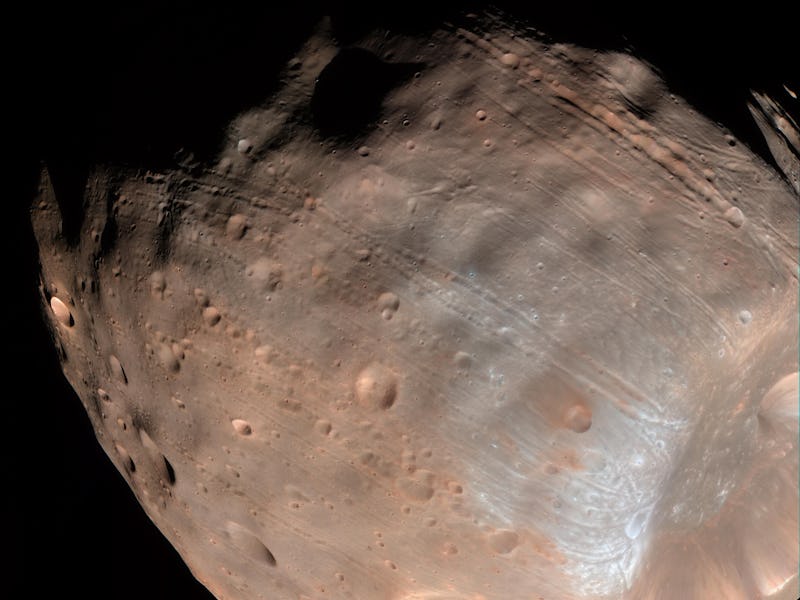Mars' Moon Phobos Is Being Pulled Apart
Those lines you see aren’t wrinkles from old age — they’re signs of imminent doom.

Mars isn’t the only rock in the neighborhood that’s past its prime. The dry, cold, atmosphere-losing planet has two moons to call its own. Bigger sibling Phobos is an irregular-shaped mess that stays closer to home. For that reason, it’s slowly falling apart.
It is literally falling apart. NASA scientists presented findings on Tuesday which suggest that long, shallow grooves on the surface of the 13.6 mile-long Phobos are early signs of structural failure that will eventually lead to the moon’s destruction.
At an orbiting distance of 3,700 miles from Mars, Phobos is closer to its planet than any other moon in the solar system. By comparison, our moon is 238,900 miles from Earth. Because the gravitational effects are stronger, Mars is actually pulling Phobos towards itself by about 6.6 feet every 100 years.
That means in about 30 to 50 million years, Phobos may actually be pulled apart.
“We think that Phobos has already started to fail, and the first sign of this failure is the production of these grooves,” said Terry Hurford of NASA’s Goddard Space Flight Center, in a press release.
For a long time, the grooves on Phobos were assumed to be fractures caused by an asteroid impact so powerful it created the 5.6 mile-wide Stickney crater — and almost destroyed the moon in the process. Grooves and crater chains have always appeared to radiate from Stickney, but we now know they are actually coming out from a focal point nearby.
Stickney crater on Phobos
Through some modeling based on new data, Hurford and his team believe the grooves are actually stretch marks caused by tidal forces created through opposing gravitational pulls between Mars and Phobos itself.
The same kind of forces actually act on the Earth and our moon as well, which leads to ocean tides and making the two bodies slightly egg-shaped. But that’s nowhere near as powerful as what seems to be happening between Mars and Phobos.
Besides the augmented gravitational forces, part of the reason this might be happening is that Phobos’ insides could just be a sorry mess. Instead of a robust core of solid rock, the Martian moon’s interior could be just rubble that’s barely held together by an outer layer that’s only 330 feet thick.
Such insides can be shifted around wildly by tidal forces. In order to keep together, the outer layer of Phobos has to constantly readjust. Scientists think this probably means the outer layer is like an elastic rubber.
Of course, as physical stress builds, the outer layer becomes weaker and weaker. Give it a few dozen million years, and you get a large space rock that finally breaks open.
Sad as it might be, Phobos seems to have a buddy in the solar system experiencing the same thing: Neptune’s moon Triton, which also has a fractured surface.
The biggest question, obviously, is what this might mean for Mars. Will the post-mortem rock pile continue to fall into the host planet? Will it float around in orbit and give the red-planet a nice cloud of dust? We just have to wait 30 million years to find out.